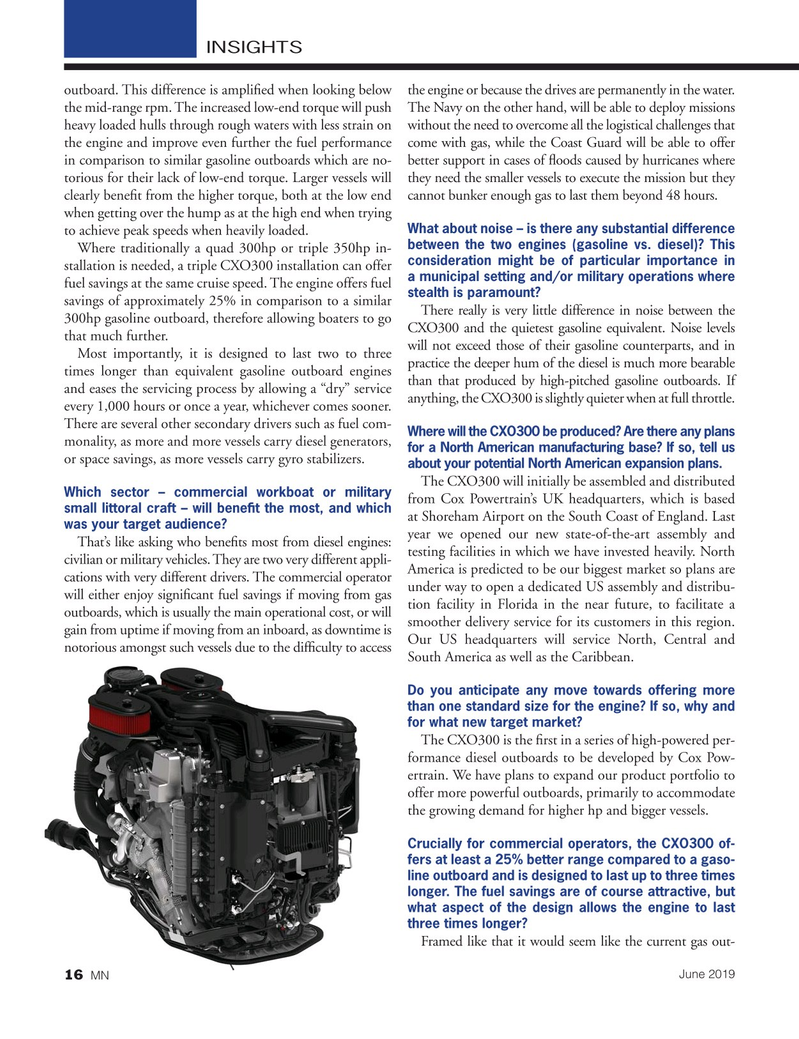
Page 16: of Marine News Magazine (June 2019)
Combat & Patrol Craft Annual
Read this page in Pdf, Flash or Html5 edition of June 2019 Marine News Magazine
INSIGHTS outboard. This difference is ampli? ed when looking below the engine or because the drives are permanently in the water. the mid-range rpm. The increased low-end torque will push The Navy on the other hand, will be able to deploy missions heavy loaded hulls through rough waters with less strain on without the need to overcome all the logistical challenges that the engine and improve even further the fuel performance come with gas, while the Coast Guard will be able to offer in comparison to similar gasoline outboards which are no- better support in cases of ? oods caused by hurricanes where torious for their lack of low-end torque. Larger vessels will they need the smaller vessels to execute the mission but they clearly bene? t from the higher torque, both at the low end cannot bunker enough gas to last them beyond 48 hours. when getting over the hump as at the high end when trying
What about noise – is there any substantial difference to achieve peak speeds when heavily loaded. between the two engines (gasoline vs. diesel)? This
Where traditionally a quad 300hp or triple 350hp in- consideration might be of particular importance in stallation is needed, a triple CXO300 installation can offer a municipal setting and/or military operations where fuel savings at the same cruise speed. The engine offers fuel stealth is paramount?
savings of approximately 25% in comparison to a similar
There really is very little difference in noise between the 300hp gasoline outboard, therefore allowing boaters to go
CXO300 and the quietest gasoline equivalent. Noise levels that much further.
Most importantly, it is designed to last two to three will not exceed those of their gasoline counterparts, and in times longer than equivalent gasoline outboard engines practice the deeper hum of the diesel is much more bearable and eases the servicing process by allowing a “dry” service than that produced by high-pitched gasoline outboards. If anything, the CXO300 is slightly quieter when at full throttle.
every 1,000 hours or once a year, whichever comes sooner.
There are several other secondary drivers such as fuel com-
Where will the CXO300 be produced? Are there any plans monality, as more and more vessels carry diesel generators, for a North American manufacturing base? If so, tell us or space savings, as more vessels carry gyro stabilizers.
about your potential North American expansion plans.
The CXO300 will initially be assembled and distributed
Which sector – commercial workboat or military from Cox Powertrain’s UK headquarters, which is based small littoral craft – will bene? t the most, and which at Shoreham Airport on the South Coast of England. Last was your target audience?
That’s like asking who bene? ts most from diesel engines: year we opened our new state-of-the-art assembly and testing facilities in which we have invested heavily. North civilian or military vehicles. They are two very different appli-
America is predicted to be our biggest market so plans are cations with very different drivers. The commercial operator will either enjoy signi? cant fuel savings if moving from gas under way to open a dedicated US assembly and distribu- tion facility in Florida in the near future, to facilitate a outboards, which is usually the main operational cost, or will smoother delivery service for its customers in this region. gain from uptime if moving from an inboard, as downtime is
Our US headquarters will service North, Central and notorious amongst such vessels due to the dif? culty to access
South America as well as the Caribbean.
Do you anticipate any move towards offering more than one standard size for the engine? If so, why and for what new target market?
The CXO300 is the ? rst in a series of high-powered per- formance diesel outboards to be developed by Cox Pow- ertrain. We have plans to expand our product portfolio to offer more powerful outboards, primarily to accommodate the growing demand for higher hp and bigger vessels.
Crucially for commercial operators, the CXO300 of- fers at least a 25% better range compared to a gaso- line outboard and is designed to last up to three times longer. The fuel savings are of course attractive, but what aspect of the design allows the engine to last three times longer?
Framed like that it would seem like the current gas out-
June 2019 16 MN

 15
15

 17
17
